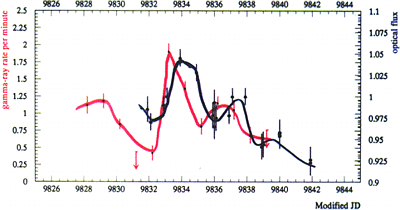
2.3.2 BLAZARS
One of the major accomplishments of gamma-ray astronomy in recent times
has been the detection of high-energy gamma-rays from a class of active
galaxies termed "blazars." The observed luminosity of some of
these at gamma-ray energies exceeds that at other wavebands by as much
as two orders of magnitude; energy considerations demand that the gamma-ray
emission be beamed. The gammarays are thought to be produced in jets containing
highly relativistic plasma, moving with roughly the same Lorentz factors
required to explain the superluminal motions detected in many sources.
The timescale of variability of the gamma-ray emission is shorter than
at radio frequencies, implying that the gammarays originate in the portion
of the jet that lies between the central engine and the radio jet imaged
with VLBI. Very little is known about this portion of the jet. Yet it is
precisely the region where the most important physics occurs: the formation
of the jet, the acceleration of the energetic particles, the collimation
of the flow into a narrow cone, and the acceleration of the flow to Lorentz
factors up to 20 and possibly as high as 100.

Figure 2.3.2- Illustration of a blazar jet which clominates the emission from gamma-ray blazars.
In some cases, the gamma rays are detected during periods of enhanced activity at other wavelengths. In a few well-monitored objects, there is a close association between flares seen at millimeter to optical wavelengths and high gamma-ray states (e.g., PKS 0528+134 and 3C-279) and between UV to X-ray and very high-energy gamma-ray emission (e.g., Mkn 421). The particle injection/acceleration process, which appears to fluctuate rapidly, can only be studied directly by observing the GeV-TeV gamma rays. With an improvement in sensitivity of a factor of 10 in a GeV space telescope (a combination of larger effective area and better angular resolution), the number of blazars visible to a future instrument should increase by a factor of at least 30, from the present 50 to several thousand, which would (if there are not basic differences) encompass all the known blazars. A similar improvement in sensitivity in ground-based observatories will permit the detection of weaker nearby blazars as well as long-and short-term monitoring programs. Simultaneous multiwaveband monitoring will result in exciting inferences regarding relativistic jets and energetic particle acceleration in blazars. The ability to follow flares smaller than those which can be detected with EGRET, and to obtain better time resolution will lead to the derivation of the geometry and physical characteristics of the inner jet by observing time delays at different frequencies as the flare propagates along the jet.

Figure 2.3.3 - One example of AGN flare / multiwavelength time variability. Correlating gamma-ray emission with lower energies provides important diagnostics into emission mechanisms.
Of particular importance will be the measurement of the energy spectra
of gamma-ray blazars as a function of redshift, since the ability of high-energy
gamma rays to traverse large cosmic distances is limited only by photon-photon
pair production off ambient photons. For the closest blazars this cutoff
will occur at energies above 4 TeV but for the most distant objects will
occur above 30 GeV. To complete this study, observations with high sensitivity
will be required from both space-and ground-based gamma-ray telescopes.
Observations of the high-energy cutoff to the gamma-ray emission from blazars
will therefore allow an inference of the ambient photon field and may define
the epoch of galaxy formation.